You can charge your coach batteries off your car’s starter battery (your car’s alternator) for your recreational vehicle (RV) or van conversion (class B RV). , To date, I have not found a single resource that describes the pros and cons of the various ways to do just this. (I wish there had been – because it took me quite some time to figure all this out.) I’m writing this to explain the different advantages and disadvantages of the various way to charge your vehicle’s coach battery off your car’s alternator.
Electricity. You kind of need it – at least if you want to use a cell phone, a computer, an exhaust fan to keep you cool, or pretty much anything. As such, we’ll be doing a solar set up with Alevander. This will allow us to have electricity no matter where we are.
Or will it?
The Problem with Solar
The problem with solar is that the sun doesn’t always shine – or perhaps that it doesn’t always shine enough. Or, a solar setup can’t be depended upon to do its job if you’re parked in the shade.
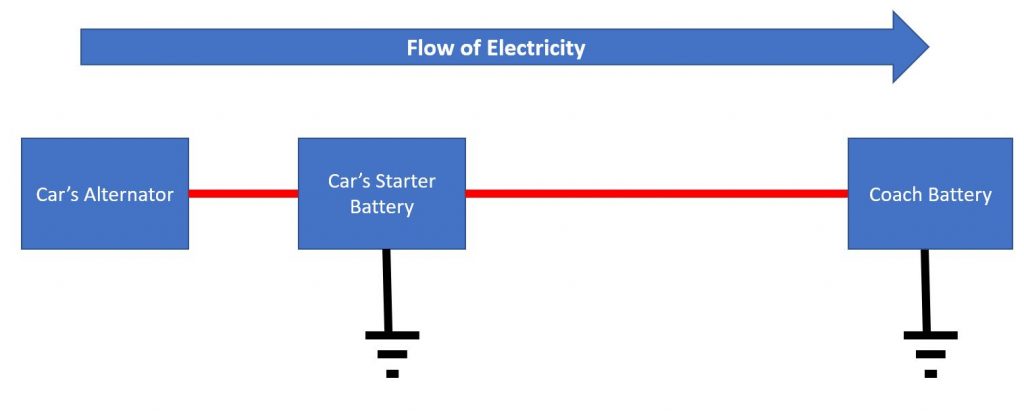
So, you need a backup option for charging for vehicle’s coach batteries. One backup option (we’ll be using) is taking electricity from the car’s alternator. (Technically, we’ll be taking electricity directly from the car’s starter battery. But, it’s the alternator that charges the car’s starter battery.)
Side Bar: What’s an Alternator?
Your car’s engine has a part on it called the alternator. The alternator generates electricity to power your car’s lights, stereo system, and other stuff. You can tap into the engine’s electricity-generating ability to power your phones, laptops, exhaust vents, etc. There are a few ways to do just that – tap into the car’s existing electrical system to charge your coach batteries.
Despite the simple diagram above, you do not want to permanently wire together our coach battery and our starting battery. That’s because doing so will drain the starter battery. This means that your car won’t start! So, we need to choose from a handful of “battery isolator” setups. We need a way to seperate or isolate these two different batteries – and only connect them when we want to: when the engine is running. There are several battery isolator setups to choose from.
A Manual Switch
A manual switch is the cheapest – and worst – way to set up your vehicle to charge your coach batteries via your car’s alternator. You do this by wiring your car’s starting battery and your cabin’s battery bank together. You put a switch in between the connection. This switch allows you to make or break the connection between your car’s starter battery and your coach batteries.

If your engine is running – and your switch is “ON” – power will run from your car’s starting battery (which is being charged by the engine’s alternator) to the batteries in your cabin. This means your coach batteries will get charged.
Pros of a Manual Switch for Charging your Coach Batteries
It’s inexpensive. All you really need is a switch and some cables.
Cons of a Manual Switch for Charging your Coach Batteries
You need to manually flip the switch “On” each time you start the vehicle. And, you have to turn the switch “Off” (breaking the connection) when you shut your engine off.
If you forget to turn the switch “On” after you start the engine, your cabin batteries don’t charge. If you forget to turn the switch “Off” after you shut off your engine, you’ll drain your starter battery. This means that you won’t be able to start your car. That’s not great.
Also, a manual switch is not the best way to charge your cabin batteries. This can shorten the battery life of your (expensive) cabin batteries. Read the following sidebar Maintaining Battery Health to learn why.
Side Bar: Maintaining Battery Health
Ever notice how the battery life of an older phone isn’t as good as the battery life of a newer phone? That’s because as batteries age, they lose their ability to hold a charge. You can speed up – or slow – the degradation of a battery depending on how you take care of that battery. This can mean (at least) at least a couple things:
Firstly, this means not letting your battery charge get too low. In this case, “too low” means below 20% for lithium batteries (i.e. your cell phone’s battery), or 50% for anything else. You can monitor your battery’s health with a voltage meter.
Secondly, this means not charging your battery properly – using the proper voltage over time. Certain batteries like to be charged a certain way. Specifically, different batteries like receiving electricity differently over time. The technical term for this is voltage. Different types of batteries require different voltages over the different stages of the battery charging process.
The consequence of not charging your batteries with the proper voltage over time means shortening the life of the battery. This means that (over time) your coach batteries will hold less of a charge.
A “smart” charger or a battery-to-battery (B2B) charger solves this problem. A B2B charger allows you to charge your battery with the appropriate voltage at the appropriate time. This extends the life of your batteries.
Automatic Charging Relays (ACR) & Voltage Sensing Relays (VSR)
Automatic Charging Relays (ACRs) and Voltage Sensing Relays (VSRs) are similar in that they turn the manual switch into an automatic switch. Now, the user doesn’t need to manually turn a switch “On” or “Off.” This is a huge upgrade over the first “con” of the manual switch set up.

Unfortunately, ACRs and VSRs are still “dumb” chargers; they don’t provide your batteries with the specific voltage at the specific times that they need for longer life. Either a dumb ACR or VSR won’t deliver the specific voltage over the various periods of the charging cycle. As another negative, ACRs and VSRs are more expensive than the manual switch option.
If battery health isn’t a priority for you, consider either an ACR or VSR. The Blue Seas ACR is especially popular with Ford Transit owners. (Our van, Alevendar the Great, is a 2015 Ford Transit.)
A Battery to Battery Charger (B2B)
Battery to battery (B2B) charger is much more expensive than the first two options. But, it solves the problem so far unaddressed: delivering electricity in a special way (voltage specific over time) to your batteries. B2B chargers are “smart” chargers. Using a smart charger means that battery life is prolonged.
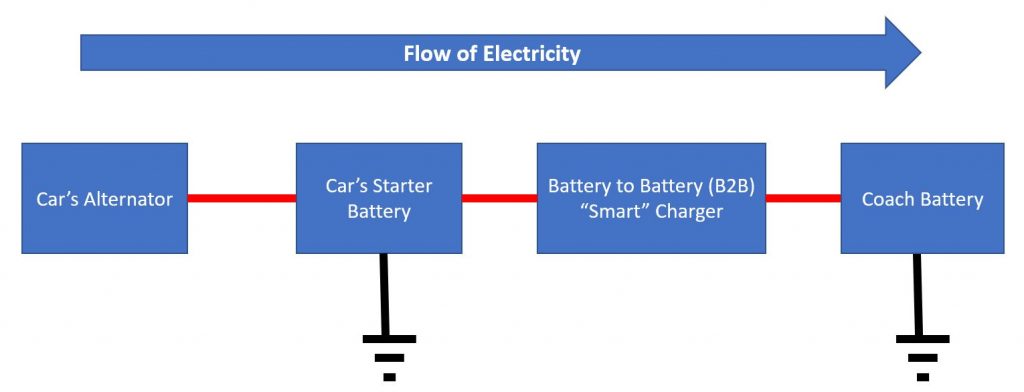
Prolonging battery life is important; you may have spent a good deal of money on your batteries. You can easily spend several thousand dollars on your battery bank – just like these guys did. Given the size of the investment in your battery bank, it may make sense to ensure that the batteries are well taken care of by opting for a smart charger.
This is the option we’ve decided to go with. We’ll be installing CTEK’s D250S as part of our van conversion. More about that later.
DC to AC to DC Charging
This is the most complex option – and might be less expensive than the B2B option. But, DC-AC-DC is still more expensive than the manual switch, VSRs, or ACRs. Moreover, a DC-AC-DC setup provides the batteries with the type of electricity they need to stay happy. That is, it’s voltage specific, because the final DC in the DC-AC-DC is in smart battery charger.
In this setup, your car’s alternator powers an inverter, creating 110-volt (AC) electricity. That electricity then goes to a battery charger (designed for home, etc., with a regular wall outlet) which chargers your cabin’s batteries.

Given the cost of buying a second inverter and a DC charger, I decided to pass on this option. Also, given the complexity of the DC-AC-DC install and the fact that the CTEK D250S doubles as a solar charge controller, I couldn’t imagine we’d save that much money going with the DC-AC-DC setup.
Our B2B Setup
We went with CTEK’s equipment. CTEK is designed specifically to work with lead acid batteries. Our battery bank is made of two Renogy 200Ah AGM batteries. (AGM, or absorbed glass mat, is a type of lead-acid battery.)
Just like a manual switch or an ACR or VSR set up, the CTEK D250S battery-to-battery charger sits between your car’s starter battery and your vehicles coach battery.
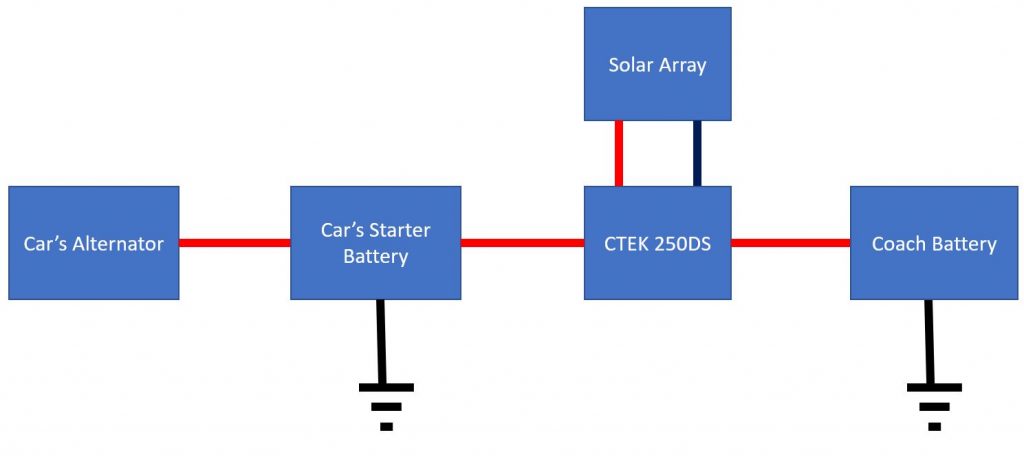
The CTEK D250S take electricity from your starter battery and then modifies it (changing the voltage) before sending that electricty to your coach battery. It is this modification process (changing the voltage, etc.) that makes the CTEK D250S a battery-to-battery charger. This is what prolongs the life of your coach batteries – and justifies the $200+ price tag of the CTEK D250S.
But, wait! There’s more. The CTEK D250S is also a solar charge controller. And given that a decent 20 amp charge controller can cost around $100, getting both a solar charge controller and a B2B charger for around $200 is kind of a good deal!

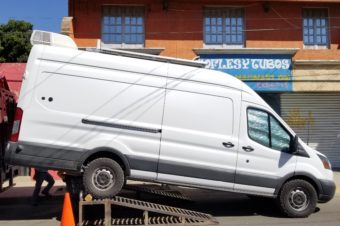

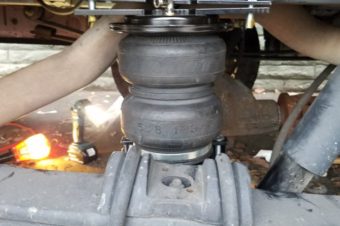
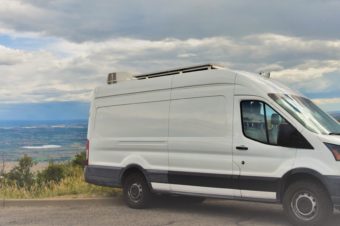
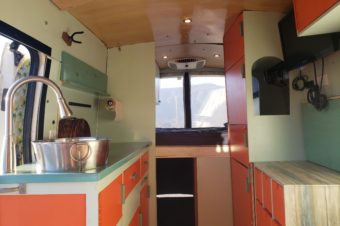
One Response
Are We “VanLife” Yet? – Dang Good Life
[…] has happened already! We have two vent fans, insulation, a subfloor frame, subfloor and even some electrical wiring done. Even though I hesitate to say I’m a vanlifer just yet, I feel like we’re getting […]